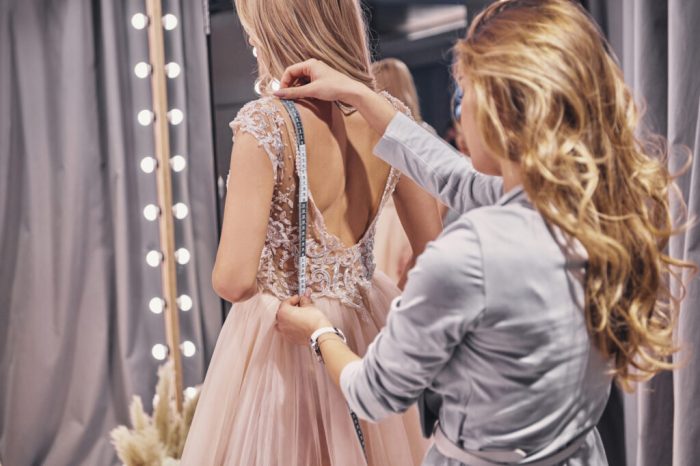Factors Influencing Wedding Dress Alteration Costs
Average wedding dress alteration cost – The cost of altering a wedding dress can vary significantly depending on several factors. Understanding these influences helps you budget effectively and avoid unexpected expenses. This section breaks down the key elements that determine the final price.
Dress Style and Alteration Complexity
The intricacy of your dress design directly impacts alteration costs. A simple A-line gown will generally require less work than a heavily embellished ballgown with multiple layers and intricate beading. More complex designs necessitate more time and specialized skills, leading to higher prices. For example, altering a mermaid gown that requires significant adjustments to the fitted silhouette will be more expensive than hemming a simple sheath dress.
Fabric Type and Alteration Cost
Fabric type plays a crucial role. Delicate fabrics like lace, silk, or tulle are more challenging to work with and may require specialized techniques, increasing the cost. Heavier fabrics, while potentially easier to alter in some ways, might need more robust tools and expertise, potentially affecting pricing as well. For instance, altering a heavily beaded lace dress requires meticulous care and specialized knowledge, leading to higher costs than altering a simple cotton dress.
Alteration Types and Price Ranges
Different alterations have different price points. A simple hemming might cost less than taking in seams, which in turn might cost less than adding or altering sleeves or a corset back. Here’s a general breakdown (prices are estimates and vary by location and seamstress):
- Hemming: $50 – $200
- Taking in seams: $75 – $300
- Adding straps: $50 – $150
- Altering bodice: $100 – $400
- Adding/removing sleeves: $150 – $500
Seamstress Experience and Location
A highly experienced seamstress with a strong reputation will likely charge more than a less experienced one. Location also plays a role; alteration costs in major metropolitan areas tend to be higher than in smaller towns or rural areas.
Geographic Variation in Alteration Costs
The cost of alterations varies significantly across different regions. This table provides a general comparison (prices are estimates and may vary considerably):
| Region | Average Hemming Cost | Average Taking-In Cost | Average Other Alterations Cost |
|---|---|---|---|
| New York City, NY | $150 – $250 | $200 – $400 | $250 – $500 |
| Los Angeles, CA | $100 – $200 | $150 – $300 | $200 – $400 |
| Chicago, IL | $75 – $150 | $100 – $250 | $150 – $350 |
| Rural areas (average) | $50 – $100 | $75 – $150 | $100 – $200 |
Typical Alteration Procedures
Understanding the common alteration processes helps you communicate effectively with your seamstress and manage expectations. This section details some of the most frequent procedures.
Hemming a Wedding Dress
Hemming involves shortening the dress length. The process typically involves removing the existing hem, pressing the fabric, and creating a new, even hem. Challenges can arise with intricate beading or lace, requiring careful removal and reattachment.
Taking In Seams
Taking in seams involves reducing the dress’s width or creating a more fitted silhouette. This usually involves carefully removing seams, pressing the fabric, and resewing the seams to the desired size. Precise measurements and careful stitching are essential to maintain the dress’s structure and aesthetic appeal.
Altering the Bodice
Bodice alterations can involve adjusting the bust, waist, or overall fit. This might involve taking in or letting out seams, adding or removing darts, or adjusting the shoulder straps. The complexity depends on the dress’s design and the extent of the adjustments needed.
Adding or Altering Straps
Adding or altering straps can involve attaching new straps, adjusting the length of existing straps, or changing the style of the straps. This process requires careful measurements and attention to detail to ensure a secure and aesthetically pleasing fit.
Common Wedding Dress Alterations
- Hemming
- Taking in seams (waist, bust, hips)
- Altering the bodice (bust, waist)
- Adding or altering straps
- Adding or removing sleeves
- Altering the neckline
- Adding or removing bustles
- Adding or altering closures (zippers, buttons)
Budgeting for Alterations
Incorporating alteration costs into your overall wedding budget is crucial. This section provides guidance on estimating and managing these expenses.
Sample Wedding Budget Incorporating Alterations
A sample budget might allocate 5-10% of the dress cost for alterations. For a $2,000 dress, this would be $100-$200. However, this is just a guideline; the actual cost will depend on the specific alterations needed.
Negotiating Prices with Seamstresses
Don’t hesitate to ask for a breakdown of the costs involved in each alteration. If you’re on a tight budget, politely inquire about potential discounts or payment plans.
Estimating Alteration Costs

Source: weddingpioneer.com
Estimate alteration costs by considering the dress style, fabric, and the number of alterations required. Getting multiple quotes from different seamstresses helps to refine your estimate.
Finding Affordable Yet Skilled Seamstresses, Average wedding dress alteration cost
Look for recommendations from friends, family, or wedding planners. Check online reviews and compare prices from several seamstresses before making a decision. Consider local sewing schools or community centers, which may offer more affordable services.
Alteration Costs Based on Dress Price Range
| Dress Price Range | Average Hemming Cost | Average Other Alterations | Total Estimated Alteration Cost |
|---|---|---|---|
| $500 – $1000 | $50 – $100 | $100 – $200 | $150 – $300 |
| $1000 – $2000 | $75 – $150 | $150 – $300 | $225 – $450 |
| $2000 – $3000 | $100 – $200 | $200 – $400 | $300 – $600 |
| Over $3000 | $150 – $300 | $300 – $600 | $450 – $900 |
Finding and Choosing a Seamstress
Selecting the right seamstress is crucial for a successful alteration. This section guides you through the process of finding and choosing a professional.
Bridal Boutique vs. Independent Seamstress
Bridal boutiques often offer alteration services, but they may charge a premium. Independent seamstresses can be more affordable but may require more research to find a skilled and reliable professional.
Questions to Ask Potential Seamstresses
Ask about their experience with wedding dress alterations, their pricing structure, their turnaround time, and their availability. Request to see examples of their previous work.
Getting Multiple Quotes
Getting at least three quotes from different seamstresses helps ensure you’re getting a fair price and comparing services.
Selecting a Seamstress Based on Reviews and Recommendations
Check online reviews and ask for recommendations from friends, family, or wedding planners. Consider visiting the seamstress’s shop to assess their workspace and professionalism.
Checklist for Choosing a Seamstress
- Experience with wedding dress alterations
- Positive reviews and recommendations
- Competitive pricing
- Clear communication and responsiveness
- Convenient location and availability
- Portfolio showcasing previous work
Visual Examples of Alterations: Average Wedding Dress Alteration Cost
Visualizing the impact of alterations helps manage expectations. The following examples illustrate the transformative power of professional tailoring.
Waist Take-In
Imagine a wedding dress with a waist measurement of 32 inches before alteration. After taking in the seams, the waist is reduced to 28 inches, creating a more fitted and flattering silhouette. The visual transformation is a noticeable slimming effect, enhancing the overall shape of the dress. The difference is easily seen in the refined fit around the midsection.
Hemming Alteration

Source: alterationsplus.us
A dress initially measuring 60 inches in length is hemmed to 56 inches. The visual change is a shorter, more proportionate length, enhancing the overall balance of the dress. The hemline is now more aligned with the wearer’s height and style preference.
Adding/Removing Sleeves
A sleeveless dress is transformed by adding delicate lace sleeves. The visual impact is significant, adding elegance and coverage. The addition of sleeves completely changes the look and feel of the dress, creating a more romantic or formal style. Conversely, removing sleeves can create a more modern or minimalist look. Measurements will vary depending on the sleeve style and the original dress design.
Helpful Answers
What’s the average cost of a simple hem?
It varies wildly, but you’re looking at anywhere from $50 to $200, depending on the dress and the seamstress.
Can I alter my dress myself?
Unless you’re a pro, it’s a big no-no. Messing up your dress could cost way more to fix than just paying a seamstress.
How far in advance should I book a seamstress?
Book ASAP! Good seamstresses get booked months, even a year, in advance.
What if I need alterations after my final fitting?
Most seamstresses will handle minor adjustments, but it might cost extra. Communicate any issues immediately.
